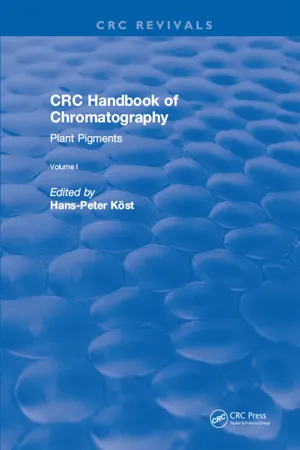
eBook - ePub
Revival: CRC Handbook of Chromatography (1988)
Volume I: Plant Pigments
Hans-Peter Kost
This is a test
- 344 Seiten
- English
- ePUB (handyfreundlich)
- Über iOS und Android verfügbar
eBook - ePub
Revival: CRC Handbook of Chromatography (1988)
Volume I: Plant Pigments
Hans-Peter Kost
Angaben zum Buch
Buchvorschau
Inhaltsverzeichnis
Quellenangaben
Über dieses Buch
The CRC Handbook of Chromatography is a series of work-bench references for scientists and researchers using chromatographic systems for the analysis of organic and inorganic compounds.This handbook is an assemblage of tables where, besides data obtained by modern separation methods, older sources often difficult to access have been included to give maximum information. For use in scientific research and routine analysis where the exact determination of plant pigments, because of their light absorbing properties and defined tasks, is necessary.
Häufig gestellte Fragen
Wie kann ich mein Abo kündigen?
Gehe einfach zum Kontobereich in den Einstellungen und klicke auf „Abo kündigen“ – ganz einfach. Nachdem du gekündigt hast, bleibt deine Mitgliedschaft für den verbleibenden Abozeitraum, den du bereits bezahlt hast, aktiv. Mehr Informationen hier.
(Wie) Kann ich Bücher herunterladen?
Derzeit stehen all unsere auf Mobilgeräte reagierenden ePub-Bücher zum Download über die App zur Verfügung. Die meisten unserer PDFs stehen ebenfalls zum Download bereit; wir arbeiten daran, auch die übrigen PDFs zum Download anzubieten, bei denen dies aktuell noch nicht möglich ist. Weitere Informationen hier.
Welcher Unterschied besteht bei den Preisen zwischen den Aboplänen?
Mit beiden Aboplänen erhältst du vollen Zugang zur Bibliothek und allen Funktionen von Perlego. Die einzigen Unterschiede bestehen im Preis und dem Abozeitraum: Mit dem Jahresabo sparst du auf 12 Monate gerechnet im Vergleich zum Monatsabo rund 30 %.
Was ist Perlego?
Wir sind ein Online-Abodienst für Lehrbücher, bei dem du für weniger als den Preis eines einzelnen Buches pro Monat Zugang zu einer ganzen Online-Bibliothek erhältst. Mit über 1 Million Büchern zu über 1.000 verschiedenen Themen haben wir bestimmt alles, was du brauchst! Weitere Informationen hier.
Unterstützt Perlego Text-zu-Sprache?
Achte auf das Symbol zum Vorlesen in deinem nächsten Buch, um zu sehen, ob du es dir auch anhören kannst. Bei diesem Tool wird dir Text laut vorgelesen, wobei der Text beim Vorlesen auch grafisch hervorgehoben wird. Du kannst das Vorlesen jederzeit anhalten, beschleunigen und verlangsamen. Weitere Informationen hier.
Ist Revival: CRC Handbook of Chromatography (1988) als Online-PDF/ePub verfügbar?
Ja, du hast Zugang zu Revival: CRC Handbook of Chromatography (1988) von Hans-Peter Kost im PDF- und/oder ePub-Format sowie zu anderen beliebten Büchern aus Naturwissenschaften & Industrielle & technische Chemie. Aus unserem Katalog stehen dir über 1 Million Bücher zur Verfügung.
Information
Part I: Carotenoids
Chromatographic Methods for the Separation of Carotenoids
INTRODUCTION
Many of the vividly red, orange, or yellow flowers and fruits, as well as a number of animals, owe their appearance to the presence of a class of more-or-less unsaturated tetra-terpenoids called “carotenoids”.1 The name comes from the carrot, Daucus carota, from which the prechromatographic “carotene” was isolated (Wackenroder, 1831); only by chromatography could it be shown that there are α-, β-, γ-, and δ-carotenes in the carrot.1, 2, 3
Since then, the carotenoids have been extensively studied in many branches of natural science.1,3, 4, 5 The greater lability of the chlorophylls during autumnal necrosis reveals the carotenoids in the “fall colors” of deciduous trees. Carotenoids are present in the thylakoid membranes of higher plants, algae, and photosynthetic bacteria; here one part of their function is to serve with lesser or greater efficiency as accessory pigments for light-harvesting in photosynthesis. They are not confined to the photosynthetic organelles; however, their presence and synthesis in so many fungi, yeasts, and bacteria which sometimes exhibit intense colors suggest another, wider function: the universal function of carotenoids as photoprotectants (compare References 3, 4, 5, 7, 8, 9).
Carotenoids are also contained in the display apparatus of a variety of flowers;10,11 here they help to attract insects. Many animals contain carotenoids, also, but only via their diet, for they cannot synthesize them as plants can. Chemically, carotenoids are hydrocarbons with numerous conjugated double bonds. The first carotenoid whose structure was elucidated (by Karrer in 1930) was lycopene, the red pigment of tomatoes and other fruits (for historic background, see References 1 and 12).
SOME REMARKS ON CAROTENOID FORMATION AND SOURCES3, 4, 5,7, 8, 9, 10,13, 14, 15
The first “typical” intermediate in carotenoid biosynthesis is isopentenyldiphosphate, which is formed via hydroxymethylglutaryl CoA and then mevalonic acid from the condensation of three molecules of acetyl CoA which arise from the intermediary metabolism of carbohydrates and lipids. By the action of an isomerase, isopentenyldiphosphate is converted to dimethylallyldiphosphate, which easily splits off a diphosphate anion while leaving a carbonium ion. The carbonium ion may now condense head-to-tail with one molecule of isopentenyldiphosphate to form geranyldiphosphate. By the addition of a further molecule of isopentenyldiphosphate, farnesyldiphosphate, a C-15 intermediate, is synthesized. After their formation from this compound, two tetraisoprenoid geranyl-geranyldiphosphates are condensed to molecules of the phytoene, a colorless compound which contains only three conjugated double bonds.
Via stepwise dehydrogenation, phytoene is converted to phytofluene, ζ-carotene, and neurosporene. Eventually, the intensely red-colored lycopene is formed. Lycopene may be converted via ring formation — the α- or β-ionone rings of α- or β-carotene, respectively.
Animal pigments may have undergone considerable modifications; an exampl...
Inhaltsverzeichnis
- Cover
- Title Page
- Copyright Page
- Table of Contents
- Part I: CAROTENOIDS
- PART II: PORPHYRINS (EXCLUSIVE OF CHLOROPHYLLS)
- PART III: CHLOROPHYLLS
- INDEX
Zitierstile für Revival: CRC Handbook of Chromatography (1988)
APA 6 Citation
Kost, H.-P. (2019). CRC Handbook of Chromatography (1st ed.). CRC Press. Retrieved from https://www.perlego.com/book/1501238/crc-handbook-of-chromatography-volume-i-plant-pigments-pdf (Original work published 2019)
Chicago Citation
Kost, Hans-Peter. (2019) 2019. CRC Handbook of Chromatography. 1st ed. CRC Press. https://www.perlego.com/book/1501238/crc-handbook-of-chromatography-volume-i-plant-pigments-pdf.
Harvard Citation
Kost, H.-P. (2019) CRC Handbook of Chromatography. 1st edn. CRC Press. Available at: https://www.perlego.com/book/1501238/crc-handbook-of-chromatography-volume-i-plant-pigments-pdf (Accessed: 14 October 2022).
MLA 7 Citation
Kost, Hans-Peter. CRC Handbook of Chromatography. 1st ed. CRC Press, 2019. Web. 14 Oct. 2022.